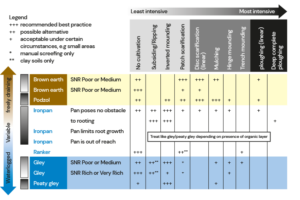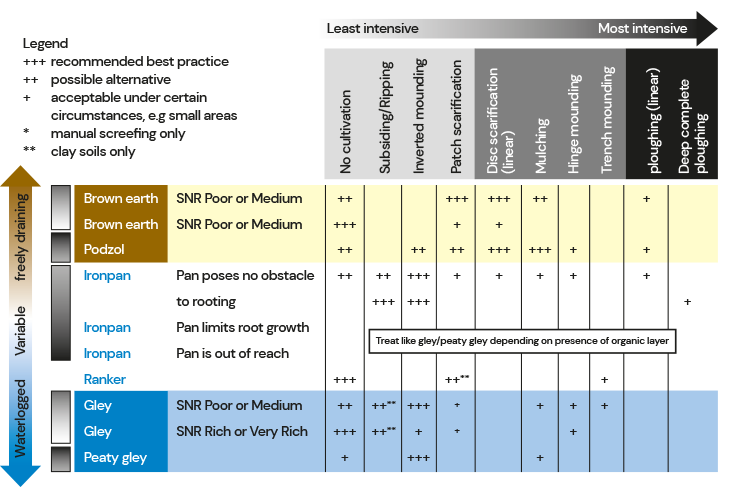Scottish Forestry Aims to Sink Carbon Emissions During Woodland Creation (FWN37 Autumn 2021)
13 December 2021There has been a great deal of discussion in recent years about the potential of trees to act as a carbon sink, sucking in carbon from the atmosphere and keeping it ‘locked away’ in the trunks, branches, and roots of trees.
However, carbon is also stored in the soils in which the trees are planted. This carbon is transferred directly into the soil through the decomposition of root systems as well as indirectly to microbes and fungi via symbiotic associations. Soils in Scotland, in general, have high levels of stored carbon, particularly in upland areas. Disturbance of the soil during ground preparation prior to tree planting has a negative effect on the balance of carbon in the soil, although this balance is replaced and enhanced throughout the length of time the trees are grown. If soil disturbance is minimised at planting stage though, the woodland will have a greater net amount of carbon stored upon maturity.
Scottish Forestry’s new guidance ‘Cultivation for Upland Productive Woodland Creation Sites’ took effect from the 1st of October 2021. A key measure introduced in this guidance will be the removal of Forestry Grant Scheme funding for any woodland creation applications that include ploughing on soils where peat depth exceeds 10 cm. Ploughing, the most invasive ground preparation technique, has been used on roughly 5% of woodland creation sites over the last few years. However, peaty soils are seen as important carbon sinks and not ploughing these soils will help to reduce unnecessary emissions. This in turn will help woodland creation fulfil its role in contributing to Net-Zero by 2045. In addition to this key measure the guidance also offers further technical advice on ground preparation methods available to achieve tree establishment objectives whilst protecting soils. Furthermore, the guidance gives advice on water management, forest stability and landscape.
Although zero ground preparation when planting trees is the preferred option there are many reasons why it is needed to aid tree survival and growth, amongst these are:
- Soil temperature: Soil temperature has been shown to influence root growth and uptake of water and nutrients. Mounding, a form of ground preparation, has been shown to raise temperatures by up to 6 degrees compared to uncultivated controls.
- Air: Subsoils can be compacted reducing oxygen, this in turn restricts root growth. Cultivation can break up the soil and increase soil aeration.
- Water: Although not a substitute for drainage some soil cultivation can create a microclimate more suitable for early growth and establishment. However, if a soil is dry cultivation can be detrimental.
- Fertility: Ground preparation can help to mix the organic and mineral layers of the soil increasing plant nutrient availability. Ground preparation is designed to help establish tree species that have been matched to the site and its conditions. Its purpose is not to alter site conditions in order to allow an unsuitable tree species to grow.
Forest Research’s Ecological Site Classification Decision Support System (ESC) can be used to ensure a tree species is suited to the site. Visit www.forestdss.org.uk/geoforestdss/
Once a suitable species has been chosen for a site, barriers to successful establishment should be identified; these barriers form the objectives of the ground preparation. In turn, differing methods of ground preparation can fulfil different objectives. The new guidance helps to clarify which ground preparation techniques can achieve which cultivation objectives.
| Technique | Capability for cultivation object(s) | |||
|---|---|---|---|---|
| Reduce weed competition for nutrients and moisture | Mix soil to improve fertility or nutrient availability | Reduce or break deep pan or induration >30cm | Create drained planting position (short-term effect) | |
| Manual screefing | Y | N | N | N |
| Sub-soiling aka ripping or tining | N | Very limited | Y | Depends on soil type |
| Patch scarification using excavator | Y | N | N | N |
| Inverted mounding | Y | Y | Y | Y |
| Hinge mounding | Y | Y | Limited | Y |
| Patch scarification using scarifier aka continuous mounding | Y | Y | N | Depends on depth scarification tool is set |
| Trench mounding | Y | Limited | N | Y |
| Rotary (helix) ploughing | Y | Depends on soil type | N | Y |
| Line scarification using disc scarifier | Y | Y | N | N |
| Shallow ploughing <30cm | Y | Depends on soil type | N | Y |
Multiple cultivation techniques can be utilised to achieve the same objective. Still, it is important that the technique with the lowest overall impact is chosen whilst still achieving the necessary objective. The lowest impact choice will mainly depend on the type of soil that is present on the site. However, other site factors will need to be taken into consideration such as if an area is within a water buffer zone, on a moderate or steep slope or is in an area of peat (up to 50cm). Overall, this new guidance will help to ensure that unnecessary soil disturbance is avoided when creating new woodland.
This will be achieved initially through the careful selection of cultivation objectives. The least intensive cultivation techniques that achieve these objectives, based on soil type, soil moisture regime and whilst considering Further information on the different types of ground preparation, their advantages and disadvantages including where they can or cannot be used are detailed within any other site constraints, can then be chosen. This will minimise the amount of carbon released during the establishment of a new woodland increasing the net carbon captured by the woodland over its lifespan.

An infographic explaining the recommended intensity of ground preparation for different soils and soil moistrure regimes (Dr Jens Haufe, Forest Research, 2021)
Further information on the different types of ground preparation, their advantages and disadvantages including where they can or cannot be used are detailed within the appendix of the ‘Cultivation for Upland Productive Woodland Creation Sites’ document as well as in the Farm Advisory Services (FAS) Ground Preparation Practice Guide.
This article has been published in the Autumn 2021 edition of the Farm Woodland News. Download a copy to access all articles. Subscribe to receive newly published editions via email by using the form here.
Sign up to the FAS newsletter
Receive updates on news, events and publications from Scotland’s Farm Advisory Service

